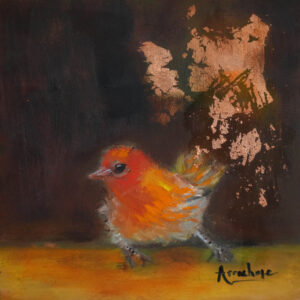Article #25 Do Acrylic Paintings Last As Long As Oil?
by Arrachme
Many people that buy art ask this question. Which should I buy, oil or acrylic paintings? Which lasts longer? Since I paint with many different mediums, I am always prepared to answer with a myriad of facts.
Often collectors are looking for art that they are emotionally attached to, to hang on their walls. They intend to acquire cherished artwork that they can pass on to their children. This desire makes longevity an important factor.
To understand the difference let’s start with the ingredients. Oil paint is comprised of pigment, binder, and solvent. The pigment is powder. The binder is usually linseed. The solvent can be turpentine or mineral spirits. Artists tend to have favorite brands that they use often. Having a favorite manufacturer may also include a tendency to deviate from a specific color or ease of mixing quality. This is perfectly fine in both oil and acrylic.
Which Artist Oil Paints?
When painting with oil, I use mostly handmade paint sources. Depending on the intended outcome I use specific colors from alternate more commonly known companies. Veridian is the only color that I purchased from the company named Rembrandt. Why? I find that the burnt umber mixes well with the recipe that Rembrandt uses for their Veridian. The Alizarin Crimson (dark red) made by the company that I use most often has too much white in their recipe, so I buy Alizarin from the Gamblin Company. Your seasoned professional artists will have built up a group of favorite paint brands. Through experience, artists formulate opinions and preferences. They know what tube of paint works best in what circumstance. For example, I use Alizarin Crimson most of the time with a deep green hue and a touch of ultramarine blue when in need of a very dark color in seascapes. Why not just use black? Mixing these colors will produce more richness and transparency. Black is very dark, but black can be opaque meaning you cannot easily see through the layers of color. This does not mean that artists don’t use black. There are many instances where black is the absolute best choice. There are so many brands and mediums on the market today that learning to combine them properly for effect and longevity is a never-ending process.
John Singer Sargent said, “Painting is easy. You just need to mix the right colors and put them in the right place.”
The Attached painting, “Wild Citizen 6” is part of my series of spunky little abstracted birds with attitude. In this case, I used copper leaf with the oil paint.
Which Acrylic Paints?

Once upon a time, artists needed to use the same brand of acrylic paint throughout a painting for consistent quality. This no longer holds. Acrylic companies have stepped up quality so much that artists can mix manufacturers’ products. It still holds to use professional quality paints and not student grade paints. Many manufacturers will offer student-grade paint and a professional grade. This means they use more fillers and less pigment to make the different levels. It can be confusing.
Acrylic paints are made of a polymer binder, pigment, and solvent. They are water-based. Polymer is another word for plastic. Many experts say that modern, high-quality acrylics will last as long as oils. Let’s add the disclaimer that the techniques used by artists play a key role in the longevity of the art. Throwing responsibility off the materials and back to the experience of the artist.
Some artists will intentionally start a painting in acrylic and then move on to oil. The process cannot be reversed. Oil paint will cover acrylic, but acrylic will never successfully cover oil. It will eventually peel off or crack because the acrylic is water-based. The water-based acrylic on top of the oil will not let the oil underneath dry. Oil and water don’t mix.
The recipe in making artist’s paints continues to change. Acrylics were unproven so they were frowned upon…until they weren’t. This article may be an encouragement to take a second look at the next acrylic painting that you encounter.
